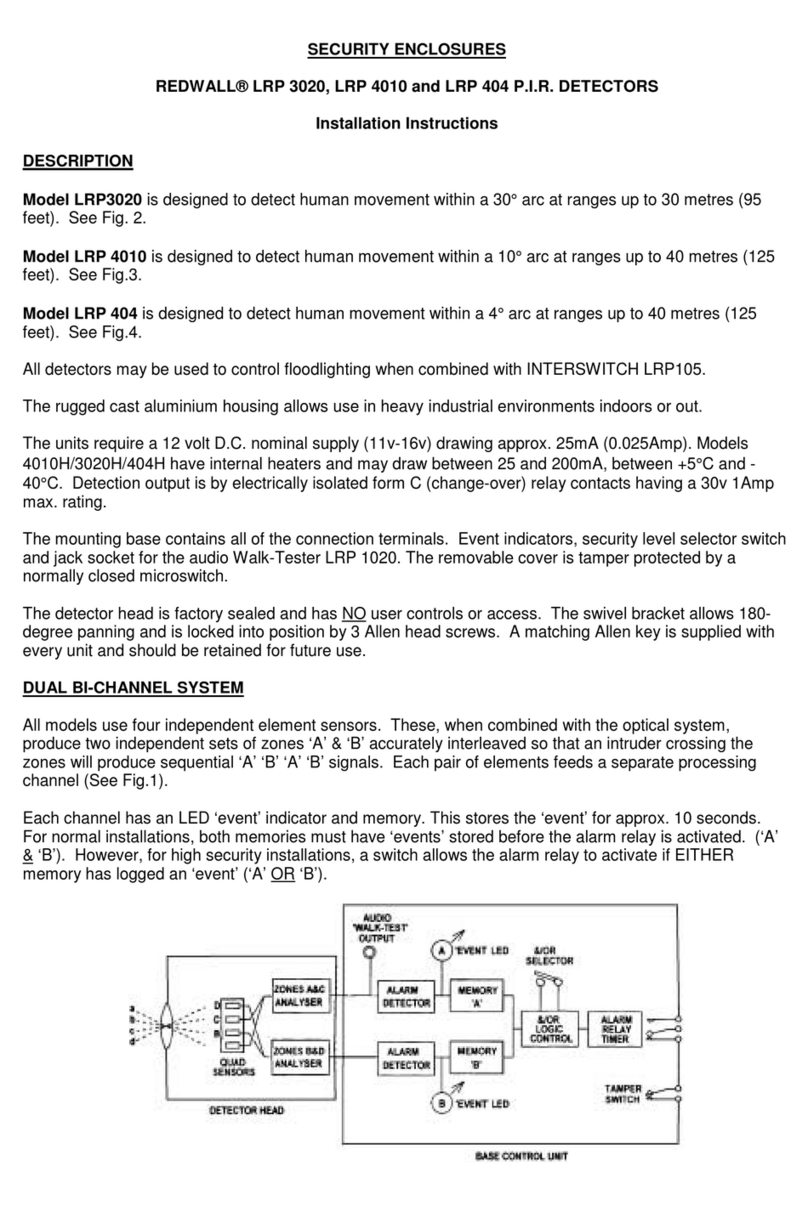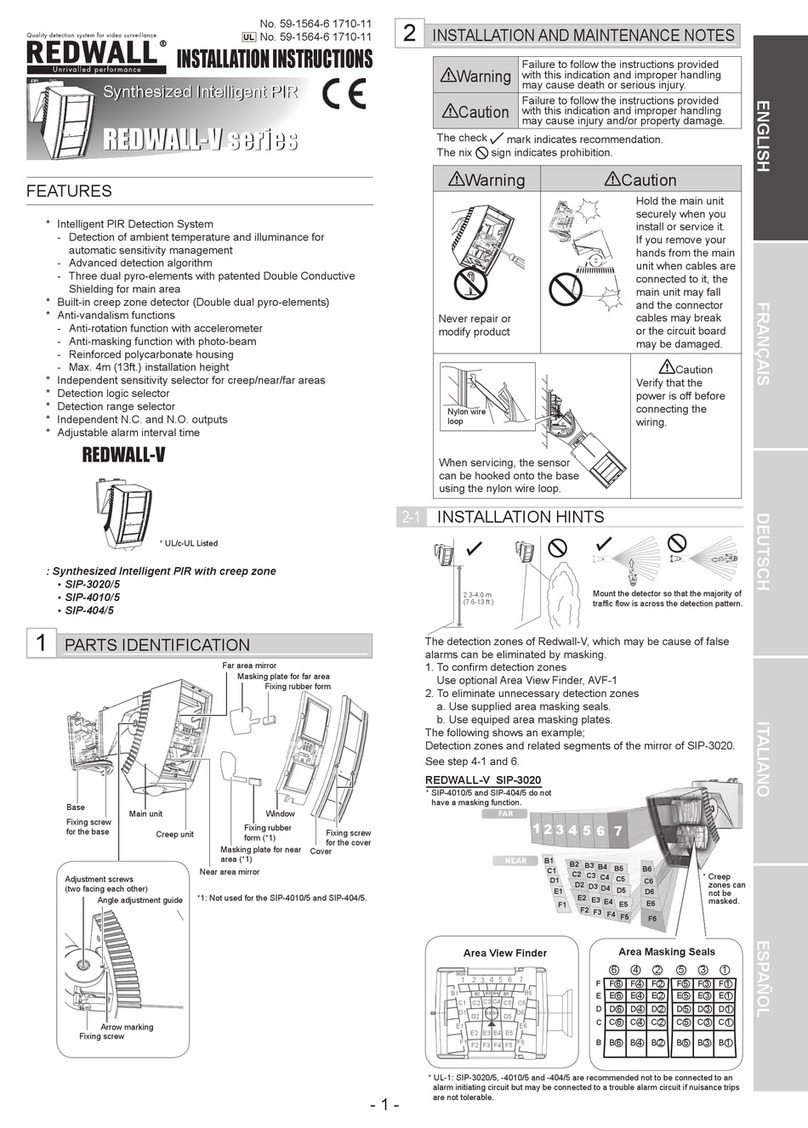
- 1 -
INTRODUCTION
1
CONTENTS
1 INTRODUCTION
1-1
BEFORE OPERATION......................................................................... 1
1-2
PRECAUTIONS ................................................................................... 2
1-3
PARTS IDENTIFICATION .................................................................... 2
1-4
INSTALLATION WORK FLOWCHART................................................. 2
2 TYPES OF INSTALLATION METHOD AND DETECTION AREAS
2-1
TYPES OF INSTALLATION METHOD ................................................. 3
2-2
TYPES OF DETECTION METHOD ..................................................... 3
2-3
AREA SETTING PROCEDURE ........................................................... 4
3 INSTALLATION AND ANGLE ADJUSTMENT
3-1
INSTALLING TO WALL OR CEILING PLANE...................................... 4
3-2
INSTALLING TO POLE ........................................................................ 5
3-3
INSTALLING AT AN ANGLE TO WALL, CEILING PLANE OR POLE .. 6
3-4
CONFIRMATION OF LOCATION OF THE LASER PLANE ................. 6
4PARTS LAYOUT INSIDE THE COVER AND THEIR FUNCTIONS
4-1
WIRING ................................................................................................ 6
4-2
SIGNAL OUTPUT................................................................................. 6
4-3
CONNECTING WALK TESTER ........................................................... 7
4-4
POWERING ON ................................................................................... 7
4-5
HEATER POWER INPUT..................................................................... 7
4-6
SWITCH LAYOUT ................................................................................ 7
4-7
LED FUNCTIONS ................................................................................ 7
4-8
INITIALIZATION TO FACTORY DEFAULT........................................... 8
5 SETTING HORIZONTAL DETECTION AREAS 1 AND 2
5-1
SELECTOR SWITCH OPERATION ..................................................... 8
5-2
MANUAL SETTING OF HORIZONTAL DETECTION AREA................ 8
5-3
STARTING SECURITY PROTECTION IN MANUAL MODE................ 9
5-4
AUTO SETTING OF HORIZONTAL DETECTION AREA..................... 9
6 SETTING VERTICAL DETECTION AREA
6-1
SELECTOR SWITCH OPERATION ..................................................... 9
6-2
SETTING DETECTION AREA IN VERTICAL DETECTION AREA .... 10
6-3
AUTO SETTING OF VERTICAL DETECTION AREA ........................ 10
7 AREA CHECKUPS
7-1
WALK TEST ....................................................................................... 11
7-2
CHANGING THE SETTINGS DURING SETUP................................. 11
7-3
SYSTEM FUNCTION AFTER POWER FAILURE.............................. 11
8 IP CONNECTION WITH REDSCAN
8-1
DEFAULT SETTINGS......................................................................... 11
8-2
REDSCAN MANAGER....................................................................... 11
8-3
REDWALL EVENT CODE ................................................................. 11
9 SPECIFICATIONS
9-1
SPECIFICATIONS OF THE MAIN UNIT ............................................ 12
9-2
DIMENSIONAL DRAWING................................................................. 12
9-3
OPTIONS ........................................................................................... 12
1-1
BEFORE OPERATION
Read this instruction manual carefully prior to installation.
This manual uses the following warning indications to provide
information regarding correct usage of the product to prevent
you and other people from being harmed and your assets
from being damaged. These warning indications are described
below.
Ensure you understand these precautions before reading the
rest of this manual.
Warning
Failure to follow the instructions provided by
this warning and improper handling may cause
death or serious injury.
Caution
Failure to follow the instructions provided by
this caution and improper handling may cause
injury and/or property damage.
This symbol indicates prohibition.
The specific prohibited action is provided in and/or around
the figure.
This symbol requires an action or gives an instruction.
Warning
Do not use the product for purposes other than the
detection of human and vehicles.
Do not use the product to activate a shutter, etc.,
which may cause an accident.
Do not touch the unit base or power terminals of
the product with a wet hand (do not touch when the
product is wet with rain, etc.). It may cause electric
shock.
Never attempt to disassemble or repair the product. It
may cause fire or damage to the devices.
Do not exceed the voltage or current rating specified
for any of the terminals, doing so may cause fire or
damage to the devices.
Ensure the power is turned off before connecting
wiring.
Confirm the signal name of every terminal to ensure
wiring is carried out correctly.
Whenever a commercial switching regulator is used,
be sure to connect PE (Protective Earth Terminal).
Hold the main unit securely when you install or
service it. Exercise care not to bump the product
against nearby objects or drop it inadvertently.
This product is not capable of detecting objects in the
dead zone of the laser scan.
Do not use this product for an application where it is
not capable of covering the detection area required
by the task.
Please note that the product can malfunction,
including producing an irregular output and
committing a detection error, if it is exposed to
unfavorable environmental conditions such as
strong ambient light, electronic noises or mechanical
vibrations.
Caution
Use of controls or adjustments or performance of
procedures other than those specified herein may
result in hazardous radiation exposure.
Clean and check the product periodically for safe use.
If any problem is found, do not attempt to use the
product as it is.
When disposing of this product, be sure to follow the
waste-disposal regulations of the country or region
where it is used.
This product is intended to detect an intruder(s)
and is not designed to prevent theft, disasters or
accidents. The manufacturer shall not be held liable
for any damage to user’s property resulting from
theft, disasters or accidents.
•
•
FEATURES
*Detection range is 30m (Approx. 100ft.) radius, max. 190 degree
*Selectable horizontal or vertical detection area
*Intelligent detection analysis for various types of application
such as PTZ camera control (*UL-1), human hand detection,
direction control, vehicle detection (*UL-2) etc. (*1)
* Recognition of the intrusion location which can activate 4
independent outputs for PTZ control (*UL-1)
*Flexible and easy setup of the required detection area
*Built-in heater (-40 - +60 °C, -40 - +140 °F)
*Selectable zone patterns for PTZ camera control using the IP
connection (*1) (*UL-3)
*1: The Redscan Manager, optional setup software, provides these functions.
INSTALLATION INSTRUCTIONS
RLS-3060SH
Laser Scan Detector
Laser Scan Detector
RLS-3060SH
(No.610494-2 : Doc 591815-7 )
(UL) 591815-7 1306-01
*UL-1: The PTZ camera feature is to be used supplementary only.
*UL-2: Vehicle detection, Fence/Wall top protection and Loitering detection modes cannot
be used for UL Listed applications.
*UL-3: For UL Listed installation applications, the unit shall be connected to a compatible
UL Listed control panel and/or UL Listed burglar alarm power supply.
This model is UL Listed product.
The comments with "*UL-Number"
are UL's requirements and infor-
mation for using this product.
Software is Ver. 7.x.x. and UL Listed Version is
Ver. 7.x. and the part number may consist of
".x" which delineates minor code error/bug fixes.
Fence/Wall top protection mode and Loitering detection mode
are new in Ver. 7.1.0.(*UL-2)(*1)
☆
Advanced area setting and Selectable detection areas function
are new in Ver. 7.1.0. (*1)
☆
REDSCAN is an area sensor that configures a fan-like detection
area of 30 m (Approx.100 ft.) radius over 190 degrees arc. using
laser beams. REDSCAN detects target objects by emitting laser
beams at the target and measuring the time required for the
emitted beams to be reflected and returned to the detector.






























